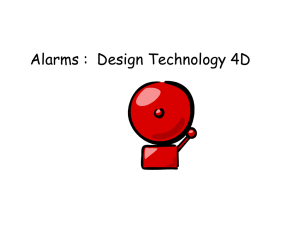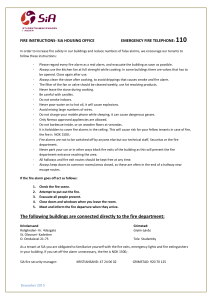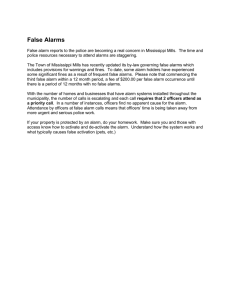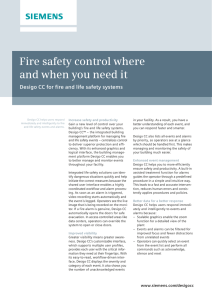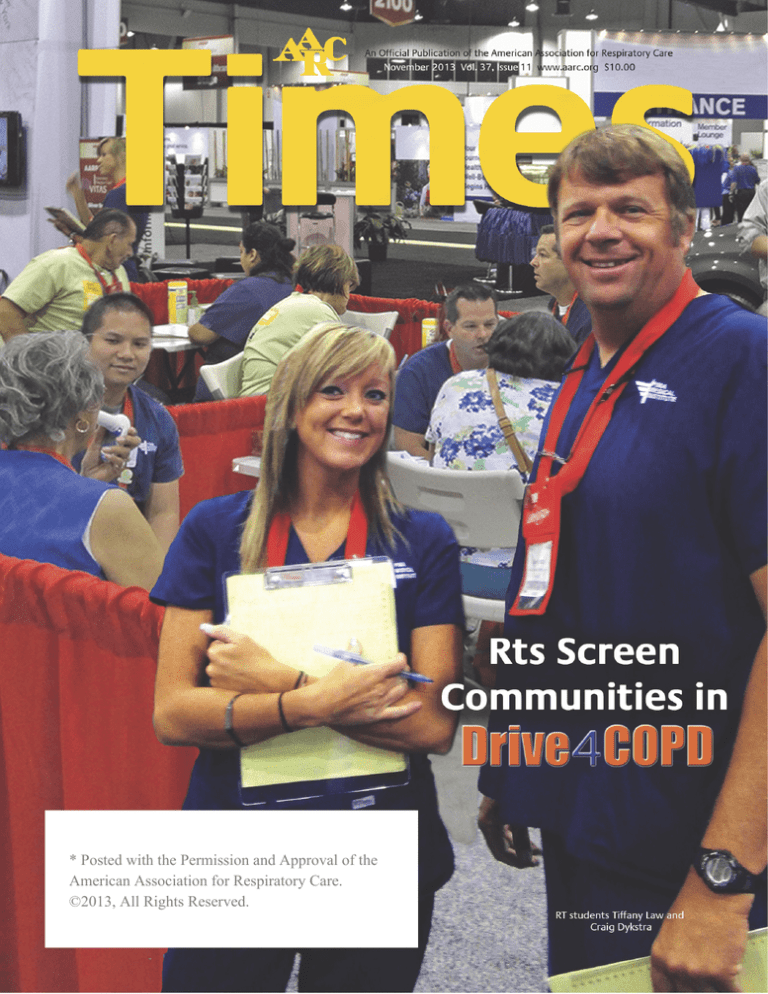
* Posted with the Permission and Approval of the
American Association for Respiratory Care.
©2013, All Rights Reserved.
Clinical Alarm Survey Update
Respiratory
National Clinical
Respiratory therapists adjust
and respond to alarms multiple
times during the course of a shift.
Alarms originate from many
medical devices, such as
mechanical ventilators, pulse
oximeters, cardiac monitors,
infusion pumps, bed alarms, and
intermittent compression devices.
42
AARC Times
November 2013
Clinical Alarm Survey Update
RTs overwhelmingly support the
implementation of smart alarms, which may at least
partially solve the problem of inadequate staff that is
available to respond to alarm events.
Therapists’ Response to a
Alarm Survey
Each alarm has its own characteristics. To complicate matters further,
there is no standardization of alarm sounds as to priority or parameter/device in alarms among manufacturers: RTs must triage among multiple alarms that demand their attention, responding according to the
perceived importance of the alarm.
The Joint Commission (TJC) reviewed 23 reports of death or injury
related to mechanical ventilation in 2002. Of these, 65% were related to
alarms.1 In January 2014, TJC will incorporate alarm management into its
National Patient Safety Goals (NPSG) in an effort “to improve the safety of
clinical alarm systems” in TJC environment of care standards.2 The major
patient safety issue identified by TJC involves the desensitization of staff
to audible alarms and the difficulty in prioritizing the many devices emitting audible alarms. In addition, the FDA Manufacturer and User Facility
Device Experience Database (MAUDE) and the ECRI Institute Problem
Reporting System were reviewed, and “alarm hazards” was identified as
About the Authors
Crystal Dunlevy, EdD, RRT,
is a clinical associate professor
at The Ohio State University
in Columbus, OH.
Shawna Strickland, PhD, RRT-NPS,
FAARC, is the AARC’s associate
executive director of education.
the number one device-related risk on ECRI Institute’s 2013 list of top 10
health technology hazards.3
AARC Times
November 2013
43
Clinical Alarm Survey Update
Alarm events
In an effort to determine the
causes of alarm events, the
Shepherd System’s Risk Model
was applied to the 237 adverse
event reports from the MAUDE database. Forty-one percent
of these event reports could not be analyzed due to the
lack of information provided; but of the remaining 59%,
53% of the alarms resulting in patient deaths were related
to operator error.4 Nuisance (false positive) alarms can also
compromise patient safety. When alarms are deemed irrelevant by clinicians, they are ignored or not responded
to immediately. Review of the medical literature reveals an
abundance of studies on nuisance alarms over the last 15
years.5–9 Subjects were monitored between 300 and 2,000
hours and included mechanically ventilated patients, pediatric ICU patients, stable emergency department patients with chest pain, and adult ICU patients. The highest
percentage of clinically significant alarm events was 8%,
and the lowest was 0.2%. To summarize, medical devices
alarm frequently, the cause of the alarm is not often clinically significant, and clinicians become desensitized to
alarms. Desensitization potentially results in poorer patient outcomes. This data suggested the need to query
caregivers about their experiences with clinical alarms in
order to decrease the occurrence of alarm-related adverse
events.
Clinical alarms survey
In 2008, the results of a national online survey on the effectiveness of clinical alarms that had been distributed to
health care providers was published in
the American Journal of Critical Care.10 The
survey was developed by a 16-member
task force made up primarily of clinical
engineers and made possible through
the American College of Clinical Engineering’s Healthcare Technology Foundation (HTF). The same Clinical Alarms
Survey with additional valuable questions was made available to RTs in 2011.
The survey consisted of four sections:
■ a section on demographic data
■ a section asking RTs to rate their opinions and
experiences surrounding clinical alarms using a fivepoint scale ranging from strongly agree to strongly
disagree
■ a section where RTs were asked to rank nine issues
that they believed to be barriers to effective alarm
management, and
■ a section that contained open-ended questions about
how to improve recognition of and response to clinical
alarms.
44
AARC Times
November 2013
Clinical Alarm Survey Update
There were 2,071 RTs who responded to
the survey. The questions and responses
from the RTs are shown in Table 1 on page
46. Ninety-eight percent of respondents
worked in an acute care facility, 63%
worked in an ICU, and 80% reported more
than 11 years of health care experience.
Ninety-five percent of RTs agreed or
strongly agreed that alarm sounds and visual displays should differentiate the priority of the alarm; 91% thought the alarm
sounds and/or visual displays should be
distinct either based on the parameter (respiratory rate, heart rate, etc.) or source (type
of device).
Regarding nuisance alarms, 72% of RT
respondents agreed or strongly agreed that
they occur too frequently. Interestingly, 84%
of nurses who responded to this question
agreed or strongly agreed that nuisance
alarms occur too frequently.
In regard to the effect of nuisance
alarms on alarm trust, 76% of RTs and 82%
of clinical managers agreed that nuisance
alarms reduce trust in alarms, causing
caregivers to inappropriately turn off
alarms at these times. In addition, 66% of
the RT respondents believed that nuisance
alarms disrupt patient care.
When RTs were asked to consider their
personal experience with clinical alarms,
only 16% reported that they found setting
alarm parameters to be overly complex,
and 65% did not believe that newer monitoring systems (defined as less than three
years old) have solved clinical alarm problems. Sixty percent of RTs who responded
did not believe that integrating clinical
alarms into TJC patient safety measures
has resulted in fewer adverse events.
While 75% of respondents believed that
alarms in use at their facility were adequate to alert staff to adverse events, nearly
30% reported that there were frequent instances when alarms were missed because
they could not be heard. Sixty-seven percent of RTs who responded to the survey
believed their peers to be sensitive to
alarms, responding quickly to an alarm
event. Half of all respondents agreed or
strongly agreed that, when numerous devices are used with a patient, it can be confusing to determine the cause of an alarm,
with 39% reporting that background noise
further interferes with alarm recognition.
Central alarm management staff devoted to receiving, prioritizing, and alerting
staff to an alarm condition was seen as
helpful by 53% of respondents, and 62%
agreed that alarm integration and communication systems such as pagers, cell
phones, and wireless devices are useful for
improving alarm management and responses. With regard to smart alarms (e.g.,
where multiple parameters, rate of change
of parameters, and signal quality are automatically assessed in their entirety), 77%
agreed that they would decrease the incidence of false alarms and 79% believed that
they would improve clinical response. Although 81% of RT respondents reported
that their facility required them to document that alarms are appropriately set,
only 59% thought that clinical policies and
procedures about alarm management were
effectively used.
Interestingly,
nearly half of
the respondents
were unsure of
the following:
■ whether an adverse
patient event
related to clinical
alarms had
occurred at their
institution in the
last two years
■ whether their
institution had
developed clinical
alarm improvement
initiatives over the
past two years, and
■ whether their
employer instituted
new technology
designed to
improve clinical
alarm safety.
AARC Times
November 2013
45
Clinical Alarm Survey Update
How RTs rank alarms:
What is needed for improvement
Table 2 on page 48 displays how
RTs ranked alarm issues in order of
most-to-least important.
Although only 11% of RTs responded, when asked specifically what is needed to improve clinical alarm recognition, RTs
suggested the following: improved training on alarm systems;
different alarms for different problems (e.g., louder, longer, or
different sounding alarms for more severe/life-threatening
clinical problems); priority alarms; and greater supervision/accountability for setting alarm parameters and responding to
and resolving alarm events.
The responses of RTs were similar to the majority of those
reported in the 2008 article where the majority of respondents
were nurses. Nuisance alarms were ranked as the most im-
portant clinical alarm issue. The majority of RTs believed that
newer monitoring systems did not impact the number of adverse alarm events, which may support comments like this
one: “It doesn’t matter how sophisticated the alarm system is
— it still takes a therapist who is properly trained and conscientious/vigilant about responding.”
RTs overwhelmingly support the implementation of smart
alarms, which may at least partially solve the problem of inadequate staff that is available to respond to alarm events
(ranked second in Table 2) by improving alarm efficiency. Finally, over 40% of RTs responded that policies and procedures
regarding alarm management at their institution were not
used effectively — this may point to the need for greater accountability and/or supervision.
Table 1
Summary of Healthcare Technology Foundation 2011 Survey: Respiratory Therapy Responses
Survey Question
Agree
Neutral
Disagree
Strongly Disagree
■ Alarm sounds and/or visual displays should
differentiate the priority of the alarm.
69.5%
25.6%
2.4%
1.7%
0.8%
■ Alarm sounds and/or visual displays should be distinct
based on the parameter (e.g., heart rate) or source (device type).
55.9%
35.3%
6.1%
2.0%
0.6%
■ Nuisance alarms occur frequently.
23.3%
48.2%
18.1%
0.2%
0.8%
■ Nuisance alarms disrupt patient care.
22.2%
44.2%
19.0%
13.6%
1.0%
■ Nuisance alarms reduce trust in alarms and cause
caregivers to inappropriately turn alarms off at times
other than setup or procedural events.
33.9%
41.6%
10.4%
12.0%
2.1%
■ Properly setting alarm parameters and alerts is overly
complex in existing devices.
3.2%
12.9%
21.9%
52.8%
9.3%
■ Newer monitoring systems (e.g., less than three years old)
have solved most of the previous problems we experienced
with clinical alarms.
3.8%
31.2%
42.9%
19.8%
2.3%
■ The integration of clinical alarms into The Joint Commission
patient safety measures have reduced patient adverse events.
5.9%
34.0%
46.6%
11.5%
2.0%
17.3%
57.4%
13.6%
10.3%
1.4%
4.9%
23.8%
17.3%
45.2%
8.8%
■ Clinical staff is sensitive to alarms and responds quickly.
11.7%
55.0%
19.3%
12.2%
1.8%
■ The medical devices used on my unit/floor all have distinct
outputs (i.e., sounds, repetition rates, visual displays, etc.)
that allow users to identify the source of the alarm.
16.8%
55.1%
13.3%
13.4%
1.5%
9.3%
40.9%
13.5%
33.2%
3.1%
■ The alarms used on my floor/area of the hospital are
adequate to alert staff of potential or actual changes in a
patient’s condition.
■ There have been frequent instances where
alarms could not be heard and were missed.
■ When a number of devices are used with a patient, it
can be confusing to determine which device is in an
alarm condition.
46
Strongly Agree
AARC Times
November 2013
Clinical Alarm Survey Update
The Joint Commission and alarm safety
The 2014 TJC NPSG includes several performance elements
with a target completion date of Jan. 1, 2016. The first goal,
set for July 1, 2014, is that the health care facility form committees to promote and recognize that alarm system safety is
a significant patient safety issue. As this patient safety goal is
focused on “managing clinical alarm systems that have the
most direct relationship to patient safety,”2 it is vital to patient safety that respiratory therapists are included in these
committees or task forces. The input from the respiratory
therapist can significantly impact the way in which the
health care facility prioritizes and manages clinical alarms.
Indeed, the majority of the focus is on physiological alarms
due to the alarm fatigue factor. It is critical that ventilator
alarm improvements be included in the process. The Joint
Commission expects that the committee work completed in
Survey Question
2014 will result in established policies and procedures for
clinical alarm management and facility-wide education by
Jan. 1, 2016.
RTs impact clinical outcomes
Clinical alarms are only one tool, albeit an important one,
in patient management. Manufacturers should design alarms
that are effective, easy to use, with standardized sounds according to priority level. Improved design (e.g., smart alarms),
coupled with adequate staff training on setting appropriate
alarm parameters, may help to reduce the incidence of nuisance alarms, which may lead to more efficient use of therapists’ time and improved patient outcomes.
The full survey can be accessed at the Healthcare Technology Foundation website: www.thehtf.org/documents/
2011_HTFAlarmsSurveyOverallResults.pdf. ■
Strongly Agree
Agree
Neutral
Disagree
Strongly Disagree
5.7%
33.0%
16.5%
40.8%
4.0%
12.5%
39.7%
37.8%
8.4%
1.6%
■ Alarm integration and communication systems via
pagers, cell phones, and other wireless devices are useful
for improving alarms management and response.
17.5%
43.5%
27.9%
9.6%
1.5%
■ Smart alarms (e.g., where multiple parameters, rate
of change of parameters, and signal quality are
automatically assessed in their entirety) would be
effective to use for reducing false alarms.
20.5%
56.6%
19.9%
2.7%
0.3%
■ Smart alarms (e.g., where multiple parameters, rate of
change of parameters, and signal quality are automatically
assessed in their entirety) would be effective to use for
improving clinical response to important patient alarms.
20.9%
57.6%
18.6%
2.6%
0.3%
■ Clinical policies and procedures regarding alarm
management are effectively used in my facility.
11.3%
47.4%
26.0%
13.9%
1.5%
■ There is a requirement in your institution to document
that the alarms are set and appropriate for each patient.
35.5%
45.8%
11.1%
6.9%
0.7%
■ Environmental background noise has interfered
with alarm recognition.
■ Central alarm management staff responsible for
receiving alarm messages and alerting appropriate staff
is helpful.
Survey Question
Yes
No
Not sure
■ Has your institution experienced adverse patient events in the
last two years related to clinical alarm problems?
16.5%
39.6%
44.0%
■ Does your institution utilize “monitor watchers” in central viewing
area to observe and communicate alarm conditions to caregivers?
49.3%
42.6%
8.1%
■ Has your institution developed clinical alarm improvement
initiatives over the past two years?
20.1%
40.5%
49.4%
■ Has your healthcare institution instituted new technological
solutions to improve clinical alarm safety?
19.9%
33.5%
46.6%
AARC Times
November 2013
47
Clinical Alarm Survey Update
Table 2
Ranking of Alarm Issues by RTs
Issue
■ Frequent false alarms, which lead to reduced attention or
response to alarms when they occur
1
■ Inadequate staff to respond to alarms when they occur
2
■ Difficulty in identifying the source of an alarm
3
■ Difficulty in understanding the priority of an alarm
4
■ Difficulty in hearing alarms when they occur
5
■ Over-reliance on alarms to call attention to patient problems
6
■ Difficulty in setting alarms properly
7
■ Lack of training on alarm systems
8
■ Noise competition from non-clinical alarms and pages
9
REFERENCES
1. The Joint Commission website. Sentinel event alert, issue 25:
preventing ventilator-related deaths and injuries. Available at:
www.jointcommission.org/sentinel_event_alert_issue_25_
preventing_ventilator-related_deaths_and_injuries/
Accessed June 20, 2013
2. The Joint Commission website. Prepublication requirements.
National patient safety goal on alarm management. Available at:
www.jointcommission.org/assets/1/18/PREPUB-06-25-2013NPSG060101.pdf Accessed Aug. 1, 2013
3. Emergency Care Research Institute website. ECRI Institute
announces its 2008 list of top 10 health technology hazards.
https://www.ecri.org/press/Pages/Top_10_Health_Technology_
Hazards.aspx Accessed June 20, 2013
4. Shepherd M. A systems approach to medical device safety. In:
Dyro J, editor. Handbook of clinical engineering. The Netherlands:
Elsevier: 2004.
5. Atzema C, Schull MJ, Borgundvaag B, et al. ALARMED: adverse
events in low-risk patients with chest pain receiving continuous
electrocardiographic monitoring in the emergency department.
48
Ranking
AARC Times
November 2013
A pilot study. Am J Emerg Med 2006;
24(1):62-67.
6. Chambrin MC, Ravaux P, Calvelo-Aros D,
et al. Multicentric study of monitoring
alarms in the adult intensive care unit (ICU):
a descriptive analysis. Intensive Care Med
1999; 25(12):1360-1366.
7. Tsien CL, Fackler JC. Poor prognosis for
existing monitors in the intensive care unit.
Crit Care Med 1997; 25(4):614-619.
8. Lawless ST. Crying wolf: false alarms in a pediatric
intensive care unit. Crit Care Med 1994; 22(6):981-985.
9. Koski EM, Mikivirta A, Sukuvaara T, Kari A. Frequency and
reliability of alarms in the monitoring of cardiac postoperative
patients. Int J Clin Monit Comput 1990; 7(2):129-133.
10. Korniewicz DM, Clark T, David Y. A national online survey on the
effectiveness of clinical alarms. Am J Crit Care 2008; 17(1):36-41.


